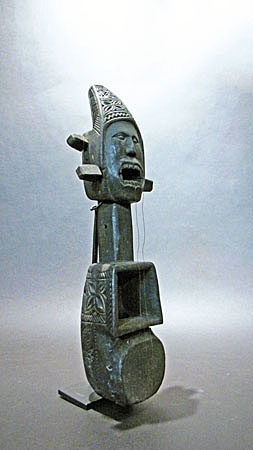
Owner: HWMC
Catalogue #: AS-CHLT-19-14
Lutes
Nepal ‘Sarangi’ (B)
Nepal
Nepalese
Wood, metal strings
Early 20th century
Length: 14 in, Width: 3 in
Chordophones – Lutes
This sarangi is a bowed chordophone played by the Gandarbha or Gaine caste of Nepal. This Nepali folk instrument is used to accompany the singing of narrative talks and folk songs. It is carved from a single piece of wood with a fretless neck and hollowed-out double-chambered body. The bottom chamber is covered with sheep or goat skin and supports a bridge for the strings, while the upper chamber is left open. This is a typical Himalayan form with triangular lateral indentations at the waist of the instrument. The strings are tied to a peg at the bottom and at the top are feed through the mouth, to the four tuning pegs of the anthropomorphic peghead. Traditionally, the sarangi was the only instrument used by the Gandarbha or Gaine caste to accompany their singing, except on occasion a Nepali drum, such as the madal. When the sarangi was played, the root note, along with the melody notes of the song was continuously bowed (as in a drone).
Resource: The Garland Encyclopedia of World Music: South Asia: the Indian subcontinent
